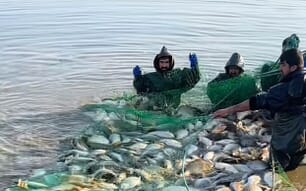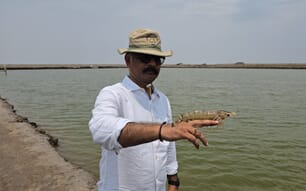
© Gurvinder Singh
Can you give a brief overview of your background?
I was born in Khatarbari, a remote village in Biswanath district, Assam. My father was a government school teacher and I completed my masters in botany from Gauhati University in 2001.
After working at the North East Institute of Science and Technology I joined a non-profit and spent 14 years travelling across different states of India.
What inspired you to start fish farming?
During my work, I saw that people were facing difficulties in accessing medical services due to poverty. And I also saw fish farmers were facing severe hardships and struggle for water.
I realised that our state was lucky to have ample water and fish farming could play a major role in bringing economic prosperity.
My grandfather had land close to the Brahmaputra River but rice farming was not possible there due to massive floods in the area during the monsoon.
So, in 2016, I formed Mahabahu Fisheries Private Limited and, a year later, I started a 10 acre carp farm.
I started farming with Indian major carp like catla, rohu, and mrigal, as well as Amur carp.
Did you face any challenges?
The initial days were tough as I didn’t have any experience and went to government institutions and farmers for help, but didn’t get much support.
I purchased around Rs 1.5 lakh ($1,750) worth of juveniles and spent the same money for feed and other expenses. I sold the produce after 8-9 months but suffered losses to the tune of nearly Rs 2 lakhs ($2,332).
However, I didn’t lose heart and read lot of books and did farming experiments. It took me three years to increase my farming area to 13 hectares in 2019.
But I was still facing losses and predators like birds were another major challenge, but things started improving in 2020.
Can you describe the current setup of your farm?
I have 50 ponds, spread across 110 acres, and a hatchery. Fortunately, diseases are very rare, because we follow proper farming protocols.
What is your annual production?
It was around 100 tonnes in 2023-2024, but increased to 150 tonnes in 2024-25. I have also produced around 50 million eggs between January and June this year.
Where you sell your produce?
We supply local markets and also have vendors who purchase the fish from us to sell on. Besides, my juveniles go to around 10 states in India.

© Gurvinder Singh
Are you involved in any social or environmental initiatives?
I don’t want budding farmers to face the same challenges as I did and I’ve so far trained over 3,000 farmers for free.
I create awareness among the farmers about the various government schemes. I also visit their farms and check the water quality. Besides, I also educate farmers on how to produce low cost feed. We also provide seeds at a 20 percent subsidised rates to farmers.
I also have a strong social media presence and educate farmers on aquaculture issues. I have created a major awareness of Amur carp in Assam.
Besides, we constructed some of our ponds without any embankments closer to the river, which helps the flow of fish into the ponds from the river during floods. We do not harvest these fish but allow locals to catch them.
Can you describe the other businesses that you run in conjunction with your farming operations?
We have four verticals that include selling feed, seed and fish at a marketable size, as well as offering a fish farming consultancy.
What are the major challenges?
We are lucky enough to have a good market as there is a gap between demand and supply. But we suffer from a shortage of raw materials, like soya cake and groundnuts, that have to be procured from afar, which is expensive.
What have been your biggest achievements in aquaculture so far?
I have been honored with an award for the best fish farmer in north east Indian and my startup was judged to be the best in the fishery sector by the government of India in 2021 and 2025 respectively.
Besides, we have a five year agreement for quality seed production with the Central Institute of Freshwater Aquaculture (CIFA), in Bhubaneswar; and a five year agreement with the Central Institute of Fisheries Education (CIFE), Mumbai for quality feed production. We have also entered into an agreement with a government college near my farm for student skills development.
What is your turnover right now?
It’s around 4 crore rupees ($456,000) annually.
How many people you employ?
I have given direct employment to 20 people while there are 50 people who buy fish from us to sell.

© Gurvinder Singh
Have you adopted any interesting technology?
Yes, we have adopting low cost feed production by making use of rice stubble, which is otherise a major cause of pollution as it is burnt by the farmers after the rice harvest. We also make use of water hyacinth and black lentils for making feed.
Our efforts have been recognised by the UN-backed International Fund for Agriculture Development (IFAD) which gave us a grant of Rs 62 lakhs ($70,435) last year to encourage us in our efforts. Our aim is to also supply low cost feed to farmers to maximise their income.
How does your farm compare to others in India?
We are creating a sustainable model of low cost aquaculture by reducing the price of the feed and also growing organic feed without any harmful chemicals. Assam has 500 hatcheries, out of which three, including ours, have been certified for quality seed production by CIFA. We have also installed a 15 kW solar energy system.
What is your advice for new farmers?
I just want to tell them that fish farming has lot of potential and has a double digit growth. Fish is becoming preferred over read meat as it boosts immunity. India is a big country where fish farming has a tremendous scope because of the huge consumer base, but people should take proper training before venturing into the sector.

© Gurvinder Singh








